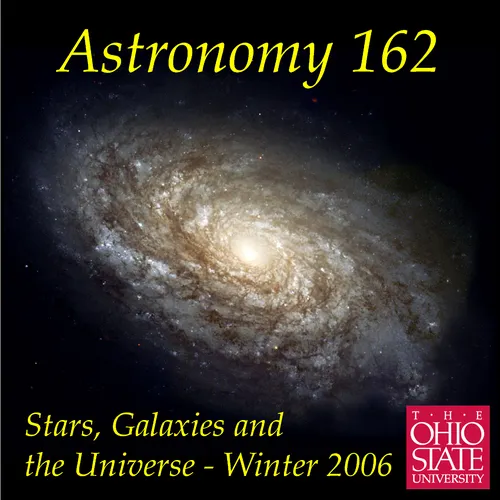
Astronomy 162 - Stars, Galaxies, & the Universe
Astronomy 162, Stars, Galaxies, and the Universe, is part 2 of a
2-quarter introductory Astronomy for non-science majors taught at The
Ohio State University. This podcast presents lecture audio from
Professor Richard Pogge's Winter Quarter 2006 class. All of the
lectures were recorded live in 1008 Evans Laboratory on the OSU Main
Campus in Columbus, Ohio.
- Update frequency
- every day
- Episodes
- 43
- Years Active
- 2006 - 2009

Lecture 27: Spirals, Ellipticals, & Irregular (Oh My!)
What are the different types of galaxies? What hints can they give
us as to the structure and evolution of galaxies? This lecture
introduces the Hubble Classification System for galaxies, and descr…
Mon 13 Feb 2006

Lecture 26: Spiral Galaxies
What are Spiral Galaxies? This lecture describes the basic
properties of spiral galaxies, their patterns of rotation and
how that lets us measure their masses, and the nature of the
spiral arms as w…
Fri 10 Feb 2006

Lecture 25: A Tale of Two Galaxies, The Milky Way and Andromeda
Andromeda is the nearest bright spiral galaxy to the Milky Way, and a near
twin in terms of stellar and gas content. This lecture discusses
the idea of stellar populations and chemical evolution in …
Thu 09 Feb 2006

Lecture 24: The Realm of the Nebulae
How did we come to understand that the Milky Way was just one of
billions of other galaxies in a vast Universe? This lecture
reviews the history of how we came to recognize that the spiral nebulae
w…
Wed 08 Feb 2006

Lecture 23: The Milky Way
What is the Milky Way, and what is our place within it? This lecture
introduces the Milky Way, the bright band of light that crosses the
sky, and describes how we came to our present understanding o…
Tue 07 Feb 2006

Lecture 22: The Cosmic Distance Problem
How do we measure distances to astronomical objects that are too far
away to use Trigonometric Parallaxes? This first lecture of Unit 4
reviews geometric methods like trigonometric parallaxes, and t…
Mon 06 Feb 2006

Lecture 21: Testing Stellar Evolution
What are our observational tests of Stellar Evolution? This lecture
discusses how we use Hertzsprung-Russell Diagrams of star clusters
to test stellar evolution theory, and some of the conclusions w…
Thu 02 Feb 2006

Lecture 20: Black Holes
What happens if even Neutron Degeneracy pressure is insufficient to
halt the collapse of gravity? In that case, the object simply collapses
in upon itself, approaching a state of infinite density. …
Wed 01 Feb 2006

Lecture 19: Extreme Stars: White Dwarfs & Neutron Stars
What happens to the cores left behind at the end of a star's life?
This lecture introduces these stellar remnants: White Dwarfs
(remnants of low-mass stars held up by Electron Degeneracy Pressure),
a…
Tue 31 Jan 2006

Lecture 18: Supernovae
Once a massive star builds a massive Iron/Nickel core at the end of
the Silicon Burning day, it is doomed. A catastrophic core collapse
is followed by explosive ejection of the envelope in a Superno…
Mon 30 Jan 2006

Lecture 17: The Evolution of High-Mass Stars
What happens when a high-mass (more than 4 solar masses) Main Sequence
stars runs out of Hydrogen in its core. At first the internal evolution
looks like that of a low-mass star, but now we get firs…
Fri 27 Jan 2006

Lecture 16: The Evolution of Low-Mass Stars
What happens to a low-mass star (less than 4 solar masses) when
it runs out of core Hydrogen and must leave the Main Sequence.
This lecture describes the changes inside a low-mass star after
Hydrogen…
Thu 26 Jan 2006

Lecture 15: The Main Sequence
What are the properties of stars on the Main Sequence? This lecture
discusses what happens to a star after it alights onto the Main
Sequence, burning H to He in its core, and maintaining a state
of …
Wed 25 Jan 2006

Lecture 14: Star Formation
How do stars form? The Sun is old and in Hydrostatic and
Thermal equilibrium. How did it get that way? This lecture
presents the basic steps of star formation as a progress from
cold interstellar …
Tue 24 Jan 2006

Lecture 13: Energy Generation and Transport in Stars
How do stars generate energy in their cores, and once made, how is
that energy transported to the surface where it can be radiated away
as Luminosity? This lecture revisits nuclear fusion and the Ke…
Mon 23 Jan 2006

Lecture 12: As Long as the Sun Shines
How long can the Sun continue to shine, and what source of energy
does it tap to keep shining? This lecture answers this question by
introducing two important energy sources for stars: Gravitational…
Thu 19 Jan 2006

Lecture 11: The Internal Structure of Stars
What are the physical laws that determine the internal structure
of stars? We first introduce the Mass-Luminosity Relation for
Main Sequence stars, as well as seeing how the mean density of stars
di…
Wed 18 Jan 2006

Lecture 10: Synthesis: The Herzsprung-Russell Diagram
How are all of the observed properties of stars (Luminosity,
Mass, Radius, Temperature and Spectral Type) related to one another?
This lecture introduces the Herzsprung-Russell Diagram, a plot of
Lu…
Tue 17 Jan 2006

Lecture 09: Stellar Spectra
What do the spectra of stars look like, and what can they tell us
about stellar properties? This lecture introduces the idea of stellar
color, gives a brief overview of the history of stellar spectr…
Fri 13 Jan 2006

Lecture 08: Stellar Masses & Radii
How do we measure the masses and radii of stars? This lecture
describes the three basic types of binary stars, and how each are
used to measure the masses of stars. Details of how to measure
stell…
Thu 12 Jan 2006
Disclaimer: The podcast and artwork embedded on this page are the property of Richard Pogge. This content is not affiliated with or endorsed by eachpod.com.